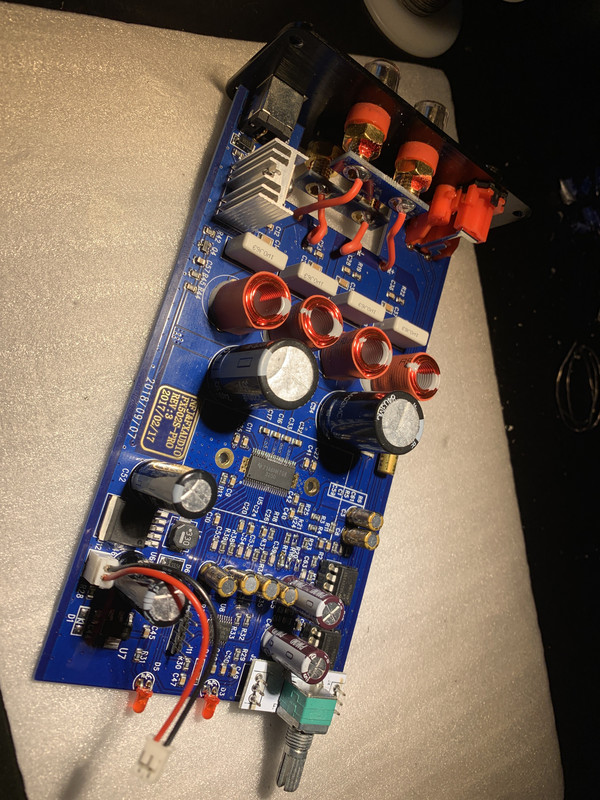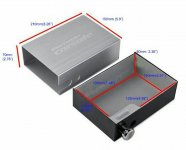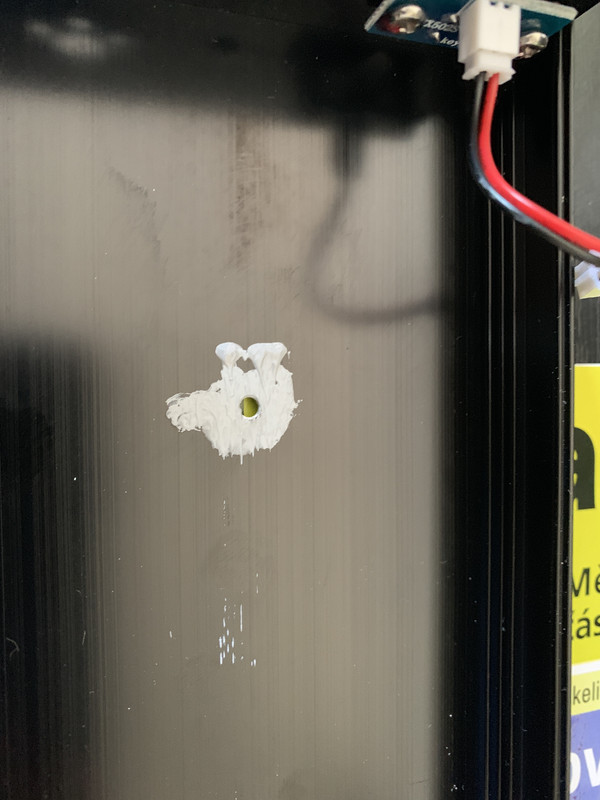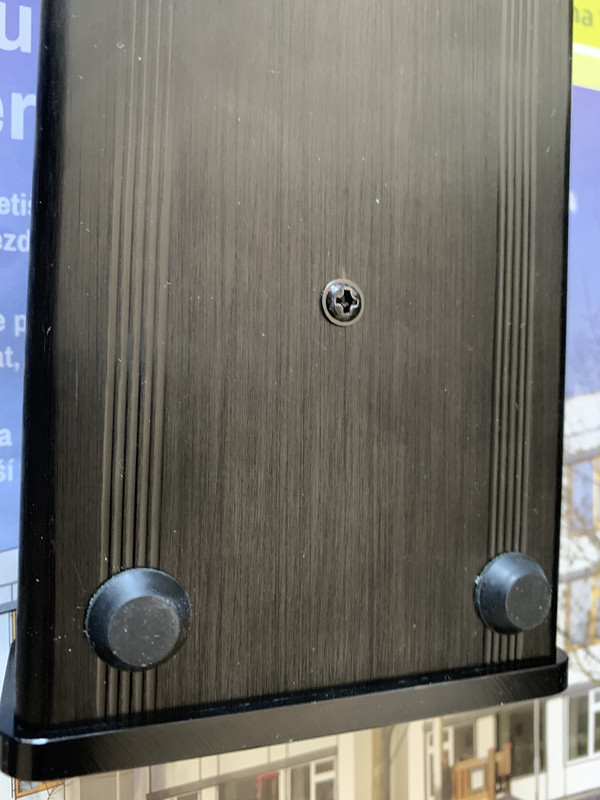Hi Overeem
you did your modification in post 717?..why the new caps?
Hi Chermann,
I didn't have this value in this kind of capacitor, so I had paralleled 2 smaller film caps. But paralleling gives ringing. On one hand it was obviously better than the original capacitor, but the ringing was not nice.
With the new caps (which are also much faster than the other film caps. which was intended), there is no ringing and now the sound is much cleaner, more details. More right, I would say.
Hi Chermann,
I didn't have this value in this kind of capacitor, so I had paralleled 2 smaller film caps. But paralleling gives ringing. On one hand it was obviously better than the original capacitor, but the ringing was not nice.
With the new caps (which are also much faster than the other film caps. which was intended), there is no ringing and now the sound is much cleaner, more details. More right, I would say.
Hi Overeem
at the fx502spro i did not the compare with kept the original caps vs my tdk caps. but at the YJTPA3255 i did this SQ compare...yes the changed caps are sounding clear better...the capacity is not the problem but i think the Q factor or the phase is not as good....
chris
from post 775
so the tpa 3250 has a gain of 26db so with this opamps config i get about 33db so its 7db more gain
is that correct?
so the volume knob- potentiometer is a voltage divider for the input and the inverted opamp has a gain about 7db....correct?
which values should i find an the pcb to get this? can some fresh brain and expert help me?
thanks chris
pump it up...
https://www.diyaudio.com/forums/class-d/315681-tpa3250-listening-78.html#post5667436
So far I am still waiting for my 32V PSU, damn postage I have a feeling they screwed it again and it got lost 
In a meantime, I managed to change my opamps for LM4562 and also all the caps for low ESR Panasonic and Nichicon with greatest possible capacity to fit the size. Also changed output foil caps for best low esr ones that could fit the size, and on all signal paths I have used Nichicon audio gold caps, hope it will help
I also changed the 30k oscillator set-up resistor, for 10k and increased switching frequency of the TPA from 450k to 600kHz. So far no listening tests just measuring it, as I have not improved my cooling yet. (still waiting for the block of aluminium to come)
It definitely produces some heat now thanks to higher frequency, but hard to tell how it will be with all the cooling mods and better PSU, as still dont have all the parts... But on low signal levels the higher switching frequency at least visually looks a lot smoother than the 450k... see the attached measurement what the residual switching poise looks like. Also on 1kHz sine wave it looked more noised before (on 450k) now the noise is so "thin and dense" its harder visible and so have a better feeling that it makes sinewave smoother on low signal levels

EDIT:
damn hard to get full res images here so here is direct link to it:
Oscillograph link here

In a meantime, I managed to change my opamps for LM4562 and also all the caps for low ESR Panasonic and Nichicon with greatest possible capacity to fit the size. Also changed output foil caps for best low esr ones that could fit the size, and on all signal paths I have used Nichicon audio gold caps, hope it will help
I also changed the 30k oscillator set-up resistor, for 10k and increased switching frequency of the TPA from 450k to 600kHz. So far no listening tests just measuring it, as I have not improved my cooling yet. (still waiting for the block of aluminium to come)
It definitely produces some heat now thanks to higher frequency, but hard to tell how it will be with all the cooling mods and better PSU, as still dont have all the parts... But on low signal levels the higher switching frequency at least visually looks a lot smoother than the 450k... see the attached measurement what the residual switching poise looks like. Also on 1kHz sine wave it looked more noised before (on 450k) now the noise is so "thin and dense" its harder visible and so have a better feeling that it makes sinewave smoother on low signal levels

EDIT:
damn hard to get full res images here so here is direct link to it:
Oscillograph link here
Last edited:
I cannot support your assumption that the residual RF-noise you see on your scope relates in some way to the SQ you can hear. Be aware this "smearing" is far above the audio-band. If you really want to judge SQ using a 100MHz scope, you should insert a 20kHz brickwall filter between measuring object and scope input. Anything else is guessing, not measuring.
okohh did know that, just assuming, that as this noise was 450k before and now it is 600k that my modification worked
hi
I've just readed the whole thread, but my knowledge about electronics is very poor and I didn't understand some things...
If I get a FX502SPRO and then I replace the opamps for a pair of LM4562NA, what should be the ideal PSU to use?
something like a linear 24v 7A regulated PSU?
Would it improve the sound compared to a a 24v 7A SMPS?
Why are some people trying with 32V PSU's if there are others forum members telling that they reached best performance feeding the FX502SPRO with 24v?
After changing the caps with better quality and higher value ones, and fixing some inconsistencies of the FX Audio circuit... would it sound better with 32V?
I can't find a good value linear PSU... if it worth it I would try to build one, but first I have to be shure what would be the ideal PSU for this amp.
thank you Cris for all that work
I'm looking for something better sounding than my Breeze Audio TPA3116 and I've heard that this FX502SPRO would stand for an audible improvement
I've just readed the whole thread, but my knowledge about electronics is very poor and I didn't understand some things...
If I get a FX502SPRO and then I replace the opamps for a pair of LM4562NA, what should be the ideal PSU to use?
something like a linear 24v 7A regulated PSU?
Would it improve the sound compared to a a 24v 7A SMPS?
Why are some people trying with 32V PSU's if there are others forum members telling that they reached best performance feeding the FX502SPRO with 24v?
After changing the caps with better quality and higher value ones, and fixing some inconsistencies of the FX Audio circuit... would it sound better with 32V?
I can't find a good value linear PSU... if it worth it I would try to build one, but first I have to be shure what would be the ideal PSU for this amp.
thank you Cris for all that work
I'm looking for something better sounding than my Breeze Audio TPA3116 and I've heard that this FX502SPRO would stand for an audible improvement
hi
I've just readed the whole thread, but my knowledge about electronics is very poor and I didn't understand some things...
If I get a FX502SPRO and then I replace the opamps for a pair of LM4562NA, what should be the ideal PSU to use?
something like a linear 24v 7A regulated PSU?
Would it improve the sound compared to a a 24v 7A SMPS?
Why are some people trying with 32V PSU's if there are others forum members telling that they reached best performance feeding the FX502SPRO with 24v?
After changing the caps with better quality and higher value ones, and fixing some inconsistencies of the FX Audio circuit... would it sound better with 32V?
I can't find a good value linear PSU... if it worth it I would try to build one, but first I have to be shure what would be the ideal PSU for this amp.
thank you Cris for all that work
I'm looking for something better sounding than my Breeze Audio TPA3116 and I've heard that this FX502SPRO would stand for an audible improvement
Hi Jdiego
power - PSU:
the Fx502Spro is an implementation of a TI TPA3250 chip in a very smal housing. so therefore i tell you that you will not get the power what is "official" provided on the commercial sites
the PSU is mondatory to offer the amp the maximum swing of your input singal to the nearly max of the voltage, e.g. 24Vpsu ---> TPA class D ---> 48 Vpeak to peak swing possibleat the output.... ideally....real about 44V-46V...noise or clipping, ringing is started.
if you not like to solder something use the origin psu and change the opamp first and enjoy the sound of this amp....its really good.
we found out here that the interal voltage regulator is set to 24V ...but the input voltage is 24V...so therefore the voltage regulator is not working correct...as i learned...the noies witch is comeing from the psu cannot get "filtered" by this regulator....this could be a a topic of SQ.... i decided to set the voltage regulator to 20V output for the opamps...(but still 24Vpsu for the tpa chip!)
so to let the origin voltage regulator LM317 work correctly you have to use a PSU with 27V (LM317 needs §v for wokring proper) and more.
But be aware of not exeeding more than 32V because of the internal caps are rated for 35V.
i am personally us the LRS150-24V about 21 euros to have an different psu.
the SMPS can be adjusted to about eg.28V the ripple is about 200mV and that is not bad...
chris
yeah i can use original for now, thats for sure. Just informing what my plans are  but still want to improve cooling as at the moment i dont have any heatsink there... still waiting for the bottom piece to attach it to case and I dont want to add the oem heatsink for now with all the thermalpaste and than again dissasembling it etc...
but still want to improve cooling as at the moment i dont have any heatsink there... still waiting for the bottom piece to attach it to case and I dont want to add the oem heatsink for now with all the thermalpaste and than again dissasembling it etc...
btw chermann did you have the 1mm thick small aluminium extension piece between main heatsink and tpa chip too? without it, my heatsink is in contact with smd capacitors so they had to use it, just i am curious if this is the feature or only my amp got that.
btw chermann did you have the 1mm thick small aluminium extension piece between main heatsink and tpa chip too? without it, my heatsink is in contact with smd capacitors so they had to use it, just i am curious if this is the feature or only my amp got that.
......btw chermann did you have the 1mm thick small aluminium extension piece between main heatsink and tpa chip too? without it, my heatsink is in contact with smd capacitors so they had to use it, just i am curious if this is the feature or only my amp got that.
yes ..the small piece of 1mm alu ....it is normal at my 2 amps..
but you can improve the cooling with alu wahsers instead the nylon once
Looks nice, thats a perfect sized enclosure.Hi
the Earth connection is done - additionally on case + correct the switch indicator lamp if its power on.
my son (10) helped me once again to build this...
Does it work well or the closed chassis is causing the SMPS to heat up?
Looks nice, thats a perfect sized enclosure.
Does it work well or the closed chassis is causing the SMPS to heat up?
no heat problem during loud listening in the living room. the power you need does not exceed the max power what the smps can deliver....so no problem that the smps get s in trouble with heat...look at the datsheet of the LRS150-24
chris
Attachments
So far I am still waiting for my 32V PSU, damn postage I have a feeling they screwed it again and it got lost
...
Hope you get your 32v PSU soon, pls be aware there will be pop sound when powering off.
Couldn't find a cheap aluminum enclosure for the SMPS, so I bought this 10 bucks car safe [emoji90]Hi
the Earth connection is done - additionally on case + correct the switch indicator lamp if its power on.
my son (10) helped me once again to build this...
I can't understand why the right ones cost 3 times the SMPS.

guide/summary/list of mods for fx520spro ???
hi guys,
i am a reader for past year and new member ,
i am interested to try this amp , i have ordered it ...now i am rookie at electronics and new to diy , but i think i can do soldering and mods..now
is there a post or guide available for the list of modifications fro fx520spro ??
or can some make a summary ???
is it possible to use opa1612 opamp insteed of lm4562 ???
opa1612 is way better in for noise(1.1nv/root*Hz) and slew rate(27v/us) and thd(0.000015%) anyone used it ???
are there better or similar alternative for opa1612 ??
why use 32v power supply ???
how much improvement in measurement by increasing switching frequency from 450k to 600kHz??
how to increase switching frequency from 450k to 600kHz ??
is it possible to use this with 16ohm speakers ??
anything else i am missing out ???
@chermann,, @ Wiliks and other senior/experienced members please help us out ,
i also would like to thank you diyaudio community and members like chermann for their significant contribution and guidance, i learnt so much by reading this forum about audio
hi guys,
i am a reader for past year and new member ,
i am interested to try this amp , i have ordered it ...now i am rookie at electronics and new to diy , but i think i can do soldering and mods..now
is there a post or guide available for the list of modifications fro fx520spro ??
or can some make a summary ???
is it possible to use opa1612 opamp insteed of lm4562 ???
opa1612 is way better in for noise(1.1nv/root*Hz) and slew rate(27v/us) and thd(0.000015%) anyone used it ???
are there better or similar alternative for opa1612 ??
why use 32v power supply ???
how much improvement in measurement by increasing switching frequency from 450k to 600kHz??
how to increase switching frequency from 450k to 600kHz ??
is it possible to use this with 16ohm speakers ??
anything else i am missing out ???
@chermann,, @ Wiliks and other senior/experienced members please help us out ,
i also would like to thank you diyaudio community and members like chermann for their significant contribution and guidance, i learnt so much by reading this forum about audio
Hi aks
welcome to dyiaudio
at page 23 i start a list of modifications..https://www.diyaudio.com/forums/class-d/315681-tpa3250-listening-23.html#post5372709
.but please read through the pages.
if you are not skilled with soldering then start with changing the opamps. remember the opamps are in the correct housing- not SOIC!
about opamps i can´t help you...i just know that as you change the opamp for the buffer - it can happen that the opamp "ring" in the amp..in my amps not.
the different values in the datasheet says nothing about sound. i changed between 3 opamps and there is a small difference..i think because the orign opamp are fake teh difference is big in SQ
sorry but i still have no THD equipment
450k--> 600kHz...-->Wiliks
you can use 32V ...as i described pages before
this amp is a litte nice sounding amp at the beginning but not as powerfull as an 3E board or Ti EVMboard...if you can live with about 20-30Watts in your listening room then ok.
for 16Ohms speakers ...which one? its needed to keep the voltage about 32V
chris
welcome to dyiaudio
at page 23 i start a list of modifications..https://www.diyaudio.com/forums/class-d/315681-tpa3250-listening-23.html#post5372709
.but please read through the pages.
if you are not skilled with soldering then start with changing the opamps. remember the opamps are in the correct housing- not SOIC!
about opamps i can´t help you...i just know that as you change the opamp for the buffer - it can happen that the opamp "ring" in the amp..in my amps not.
the different values in the datasheet says nothing about sound. i changed between 3 opamps and there is a small difference..i think because the orign opamp are fake teh difference is big in SQ
sorry but i still have no THD equipment
450k--> 600kHz...-->Wiliks
you can use 32V ...as i described pages before
this amp is a litte nice sounding amp at the beginning but not as powerfull as an 3E board or Ti EVMboard...if you can live with about 20-30Watts in your listening room then ok.
for 16Ohms speakers ...which one? its needed to keep the voltage about 32V
chris
cheers, finally local post found my package and i got it! 

Already tried it and.... wow! what a power, i think it has like twice as much juice as before no measurements yet as I still havent tweaked my cooling solution, will get to it during weekend or so, so will keep you posted with my findings what a power it is capable on 600kHz and 32V PSU
no measurements yet as I still havent tweaked my cooling solution, will get to it during weekend or so, so will keep you posted with my findings what a power it is capable on 600kHz and 32V PSU  I hope it will at least close to datasheet values.
I hope it will at least close to datasheet values.

Already tried it and.... wow! what a power, i think it has like twice as much juice as before
Finally i finished tuning of the amp! The cooling is from below by 5mm thick aluminium piece, I used arctic cooling mx4 thermal compound that even got into the vias below tpa chip, to avoid any shorts to surrounding pcb vias i used kapton insulation film below the aluminium brick and another tape for surrounding paths just to be sure its insulated properly. This tpa chip is indeed cooled from below as the purple heatsink is now barely warm  here is how it looks like:
here is how it looks like:



I did also some measurements and this is how a small signal (5VRMS) looks like with 600k switching noise:
002 — Postimage.org
This one is full power into 8R load, both channels driven, 2x55W! no heat issues at all:
full power 8 R — Postimage.org
I tried it also into 4R load, both channels driven and wow!, i got amazed, it did 2x90W RMS!!! what a powerfull small amp it is, i am very surprised, and with improved cooling almost no heat generated, beautiful technology
I am just sad, they dont produce it as this tuned version, directly when you buy it from ebay or so...



I did also some measurements and this is how a small signal (5VRMS) looks like with 600k switching noise:
002 — Postimage.org
This one is full power into 8R load, both channels driven, 2x55W! no heat issues at all:
full power 8 R — Postimage.org
I tried it also into 4R load, both channels driven and wow!, i got amazed, it did 2x90W RMS!!! what a powerfull small amp it is, i am very surprised, and with improved cooling almost no heat generated, beautiful technology
I am just sad, they dont produce it as this tuned version, directly when you buy it from ebay or so...
Last edited:
- Home
- Amplifiers
- Class D
- TPA3250 somebody is listening?
